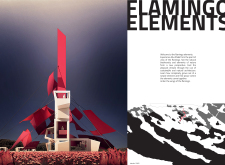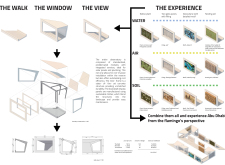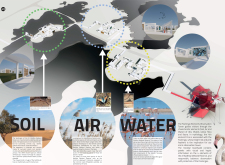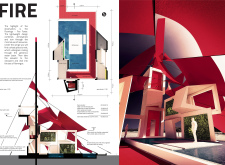5 key facts about this project
Functionally, the Flamingo Elements project operates as both an educational and explorative platform. It provides visitors with various interactive and observational experiences connected to the surrounding wetland environment. The design is compartmentalized into three thematic areas: Water, Air, and Soil, which together contribute to understanding the intricate relationships between these elements and the wildlife thriving within them. Each area is carefully crafted to create unique sensory experiences that allow individuals to connect more profoundly with the natural world around them.
Key components of the design include modular features that maximize both usability and sustainability. The architecture utilizes a prefabricated approach, which enhances construction efficiency while reducing environmental impact. Notably, the structure is comprised of several modular units that are cleverly arranged to define spaces within the tower. This modularity promotes versatility, allowing for easy adjustments and adaptations to the project as needed over time.
The structural elements are designed with durability and aesthetics in mind. Predominantly made of concrete, the tower's foundation ensures longevity and stability. The use of wood panels not only provides a warm visual appeal but also reflects a dedication to sustainable practices. Large glass surfaces integrated throughout the design facilitate natural light penetration and provide unobstructed views of the wetlands, inviting a dialogue between the visitors and the landscape. The striking red fabric shading elements are inspired by the flamingos themselves, creating visual interest and serving practical purposes by controlling solar gain.
Unique design approaches are evident throughout the Flamingo Elements project. The inspiration drawn from natural forms and colors reflects a broader commitment to biophilic design principles, which prioritize connections to nature in built environments. The structure is not merely an observation point; it aims to engage visitors in learning about conservation efforts while being immersed in the local ecosystem. Interactive panels are strategically placed to educate visitors about the flora and fauna of the reserve, outlining the importance of biodiversity and habitat preservation.
Overall, the Flamingo Elements project exemplifies how architecture can harmoniously integrate with nature while serving educational and functional purposes. Each detail, from the building materials to the interactive features, contributes to a cohesive narrative about protecting and appreciating the environment. This design fosters an understanding of the ecological challenges faced by such habitats and encourages stewardship among visitors.
For those interested in a deeper understanding of this architectural project, exploring the architectural plans, architectural sections, and architectural designs will yield further insights. The thoughtful integration of innovative architectural ideas throughout the Flamingo Elements project illustrates the potential of architecture to create meaningful connections between people and the environment.


























